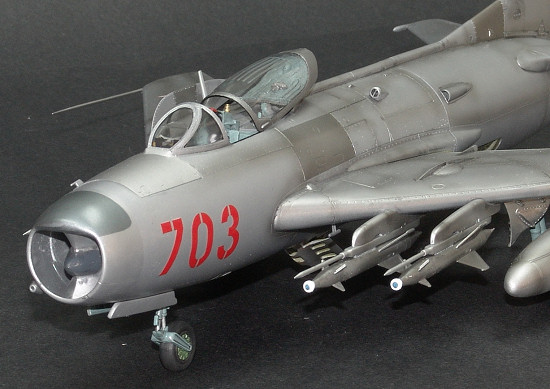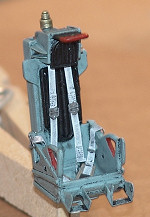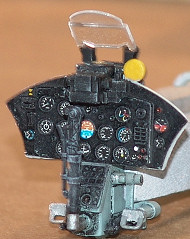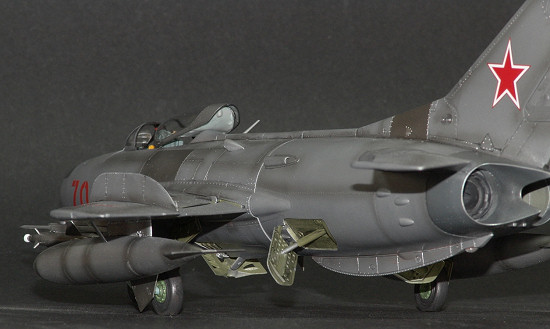
Trumpeter 1/32 MiG-19PM 'Farmer E'
| KIT #: | ? |
| PRICE: | $49.95 MSRP |
| DECALS: | Two options |
| REVIEWER: | Jeff Brundt |
| NOTES: |

| HISTORY |
One of the Worlds first level
supersonic fighters the MiG-19 is a significant fighter that is often overlooked
by both aviation history texts and model manufacturers. Sturdy and easy to
handle the MiG-19 was popular among pilots (many of which claim that it is a
better fighter in many respects than the MiG-21 which replaced it) since it can
out turn and outclimb its successor up until 20,000 ft. The MiG-19 has been
described as a triumph of brute force over beauty and although lacking in almost
every regard compared to modern aircraft, its two 30mm cannon give it
considerable stopping power making it useful in ground attack missions. The
 design project was authorized in 1951 just as the Korean War was breaking out. A
'T' tailed prototype proved lethally flawed but the design soon got back on
track and went into production in the closing months of 1954.
design project was authorized in 1951 just as the Korean War was breaking out. A
'T' tailed prototype proved lethally flawed but the design soon got back on
track and went into production in the closing months of 1954.
An all weather version was also produced (MiG-19P) with the MiG-19PM being the final version in 1958 which replaced the guns with missiles. Soviet allies such as Czechoslovakia and Poland kept production going into the 1960's and some were even seen fighting the Mujahideen during the Afghan War. In 1958 China secured a manufacturing license and produced the aircraft as the Shenyang J-6. When China and Russia fell out diplomatically the Chinese were left with no prospect of a better replacement and an attempt to copy the MiG-21 failing the Chinese upped production and produced several versions. In 1970 China produced a radically different version of the MiG-19 as a ground attack aircraft named the Nanchang Q-5 'Fantan' by the West. This proved a great success as a cheap ground attack aircraft able to carry 200kg of weapons, twice that of the normal MiG-19. The Q-5 has been exported by the Chinese to several countries giving the MiG-19 an amazing record of nearly 50 years in frontline service around the world.
| THE KIT |
 The Trumpeter 1/32 MiG-19PM is a
gem of a model and stands up to anything that Tamiya or Hasegawa has to offer.
It comes in a pretty good sized, sturdy box with a LOT of sprues. The same kit
can be used to build a Chinese J-6 version so pay careful attention to the
instructions as to which parts to use and what holes need to be opened up. There
is nicely engraved surface detail (which is not overdone as on other Trumpeter
kits) and two excellent, well detailed Tumansky RD-9 turbojet engines with resin
parts that depict the accessory section of the turbojet engines. There are
plenty of weapons sprues as well, including two versions of the AA-1 Alakali
(RS-1A/RS-2) missiles along with various other bombs. The bombs are not used on
the Farmer E (they were only used on the earlier, Farmer C models) so you can
relegate them to the spares pile or use them on Trumpeter's MiG-19 'Farmer C'
kit (which, for some strange reason doesn't include weapons)
The Trumpeter 1/32 MiG-19PM is a
gem of a model and stands up to anything that Tamiya or Hasegawa has to offer.
It comes in a pretty good sized, sturdy box with a LOT of sprues. The same kit
can be used to build a Chinese J-6 version so pay careful attention to the
instructions as to which parts to use and what holes need to be opened up. There
is nicely engraved surface detail (which is not overdone as on other Trumpeter
kits) and two excellent, well detailed Tumansky RD-9 turbojet engines with resin
parts that depict the accessory section of the turbojet engines. There are
plenty of weapons sprues as well, including two versions of the AA-1 Alakali
(RS-1A/RS-2) missiles along with various other bombs. The bombs are not used on
the Farmer E (they were only used on the earlier, Farmer C models) so you can
relegate them to the spares pile or use them on Trumpeter's MiG-19 'Farmer C'
kit (which, for some strange reason doesn't include weapons)
| CONSTRUCTION |
 While the stock cockpit is nice I
enhanced mine with Eduardís PE detail set. It really makes a difference,
especially on the instrument panel. The kit's ejection seat alone contains over
10 parts and is enhanced even more with the Eduard PE. The interior was painted
RLM 76 which is a very close match to Russian interior blue/grey. It was then
given a black enamel wash to bring out details. This plane requires quite a bit
of nose weight to prevent it from bei
While the stock cockpit is nice I
enhanced mine with Eduardís PE detail set. It really makes a difference,
especially on the instrument panel. The kit's ejection seat alone contains over
10 parts and is enhanced even more with the Eduard PE. The interior was painted
RLM 76 which is a very close match to Russian interior blue/grey. It was then
given a black enamel wash to bring out details. This plane requires quite a bit
of nose weight to prevent it from bei ng a tail sitter (especially if you install
the engines). I was able to epoxy lead shot and BBís in the nose air splitter
intake halves before gluing them together. The air splitter is then glued to the
cockpit assembly and they are then sandwiched between the fuse halves.
ng a tail sitter (especially if you install
the engines). I was able to epoxy lead shot and BBís in the nose air splitter
intake halves before gluing them together. The air splitter is then glued to the
cockpit assembly and they are then sandwiched between the fuse halves.
Trumpeter provides engine exhaust nozzle covers to hide the fact that if you build the engines and leave them out of the model for external display you wonít have gaping holes in the tail end. It seemed to me quite a shame that in order to be able to have a model with uncovered and visible exhaust nozzles I would have to close up inside the fuse those beautifully detailed Tumansky RD-9 turbojet engines. I opted instead for some extra engineering and made the forward and aft fuse halve separate their intended splice line to allow for the aft fuselage section to be removable so as to view the finished engines.
In order to
do this I added some music wire guide pins and mating holes to the aft and
forward fuse halves. These pins help hold and align the fuse halves together. In
addition, the installed engines themselves also provide for added rigidity. One
engine was glued in place to its fuselage mount and the other was allowed to be
removable so it could be
 displayed next to the finished model on its included
display stand. The engines have quite a few pipes and hoses that need affixing.
The various burner sections are made up of several pieces for both length and
circumference.
displayed next to the finished model on its included
display stand. The engines have quite a few pipes and hoses that need affixing.
The various burner sections are made up of several pieces for both length and
circumference.
Building one engine is time consuming enough and doing two takes even more effort. These engines could be complete kits themselves. Once they were done they were sprayed with various shades of Model Master metalizer and Alclad II paints. After the paint had dried they were then given a black enamel wash to bring out the detail.
The model is built in several sub-assemblies; nose and forward fuse, aft fuse, wings. When the wings were completed they were joined to the forward fuse. Fit was excellent. Trumpeter did a good job of making seams on this kit correspond with actual panel lines of the real aircraft.
| COLORS & MARKINGS |
 I primed
everything with regular grey auto primer. Because this was going to be my first
NMF model I was a bit nervous. NMF can be quite intimidating because every
surface flaw or imperfection is magnified a hundredfold. I knew I would need as
perfect a surface as possible to lay the base metal color on to so the entire
model was wet sanded with 8000 grit micromesh. This got me as smooth a surface
as possible.
I primed
everything with regular grey auto primer. Because this was going to be my first
NMF model I was a bit nervous. NMF can be quite intimidating because every
surface flaw or imperfection is magnified a hundredfold. I knew I would need as
perfect a surface as possible to lay the base metal color on to so the entire
model was wet sanded with 8000 grit micromesh. This got me as smooth a surface
as possible.
The first color laid down was Floquil old silver. Most Soviet era aircraft have different shades of aluminum on the various panels so I reproduced this by masking off random panels and spraying them with different shades of Alclad II. I then did some post shading along the panel lines with Alclad II duralumin. I think this resulted in a good effect of showing a well worn Mig that has been relegated to some rear echelon area while the front line units are equipped with top of the line Mig-21ís. Following this the panel lines were highlighted with a wash to really bring out that fine surface detail.
| FINAL CONSTRUCTION |
 Once the
basic painting was done all the fiddly bits came next; landing gear, doors,
flaps, antennas, missiles, launchers, pylons, drop tanks etc. These fiddly bits
can take almost as much time as the model. When these sub-assemblies were done
and ready for installation the model was then decaled. I didnít use any of the
placards provided. There are just too many. My thought was that if this was
depicting a worn fighter than most of the data placards would be gone anyway. So
it was just red stars and unit numbers on the nose. Now all the fiddly bits
could be attached. When I was finally able to set the model on its gear my nose
weight that I added early on proved to be more than adequate. With everything
attached I gave the model a final coat of PollyScale satin acrylic to seal
everything in
Once the
basic painting was done all the fiddly bits came next; landing gear, doors,
flaps, antennas, missiles, launchers, pylons, drop tanks etc. These fiddly bits
can take almost as much time as the model. When these sub-assemblies were done
and ready for installation the model was then decaled. I didnít use any of the
placards provided. There are just too many. My thought was that if this was
depicting a worn fighter than most of the data placards would be gone anyway. So
it was just red stars and unit numbers on the nose. Now all the fiddly bits
could be attached. When I was finally able to set the model on its gear my nose
weight that I added early on proved to be more than adequate. With everything
attached I gave the model a final coat of PollyScale satin acrylic to seal
everything in
| CONCLUSIONS |
So there you have it. A really nice model of an overlooked Cold War fighter. If you are looking for a great kit of a modern era, Soviet fighter give the MiG-19 a try. Good job Trumpeter!
May 2006
Copyright ModelingMadness.com. All rights reserved. No reproduction in part or in whole without express permission from the editor.
If you would like your product reviewed fairly and quickly, please contact the editor or see other details in the Note to Contributors.